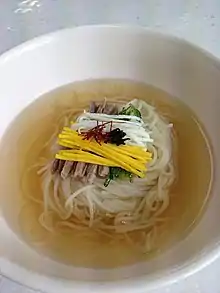Janchi-guksu
Janchi-guksu (Korean: 잔치국수)[2] or banquet noodles[2] is a Korean noodle dish consisting of wheat flour noodles in a light broth made from anchovy and sometimes also dasima (kelp). Beef broth may be substituted for the anchovy broth. It is served with a sauce made from sesame oil, ganjang and small amounts of chili pepper powder and scallions. Thinly sliced jidan (지단, fried egg), gim (laver) and zucchini are added on top of the dish as garnishes,[3] though various other vegetables or kimchi can also be used. The word janchi means "feast" in Korean, in reference to the festive occasions on which the dish is prepared, such as for a wedding or sixtieth birthday celebration.[4]
 A bowl of janchi-guksu | |
| Alternative names | Banquet noodles |
|---|---|
| Type | Guksu |
| Place of origin | Korea |
| Korean name | |
| Hangul | 잔치국수 |
|---|---|
| Revised Romanization | janchi-guksu[1] |
| McCune–Reischauer | chanch'iguksu |
| IPA | [tɕan.tɕʰi.ɡuk̚.s͈u] |
History
The name derives from the Korean word janchi (잔치, literally "feast" or "banquet"), because the noodle dish has been eaten for special occasions such as wedding feasts, birthday parties, or hwangap (60th birthday celebration) throughout Korea. The word guksu means "noodles" in Korean, and noodles symbolise longevity in life and in a marriage.[5]
There are records of guksu dating back to the Goryeo period. In the book Dongguk Isangguk Jeonjip Book 6 (동국이상국전집; 東國李相國全集) there is a mention of guksu in a line of poetry, and in the book Goryeo Dogyeong (고려도경; 高麗圖經), written by an envoy from the Chinese Song Dynasty, it is mentioned that guksu was eaten on special occasions as wheat was rare and expensive in Goryeo. The most common ingredients for noodles were buckwheat or starch.[6]
Popular culture
Because the noodles are traditionally eaten at weddings, the expression "When are you going to feed us guksu?" is a way of asking "When are you going to get married?" and a wedding day might be referred to as "a day to eat guksu".[6]
Following the impeachment of Park Geun-hye, many Koreans ate fried chicken and janchi-guksu, which trended on Korean Twitter.[7][8]
See also
- Korean cuisine
- Kuksu – a Koryo-saram dish similar to janchi-guksu
- Kal-guksu
- Noodle soup
- Sujebi
References
- 잔치국수 [feast noodles]. National Institute of Korean Language (in Korean). Archived from the original on February 13, 2018. Retrieved November 12, 2021.
- 주요 한식명(200개) 로마자 표기 및 번역(영, 중, 일) 표준안 [Standardized Romanizations and Translations (English, Chinese, and Japanese) of (200) Major Korean Dishes] (in Korean). National Institute of Korean Language. July 30, 2014. Archived from the original on February 15, 2017. Retrieved November 12, 2021.
- 잔치국수 [janchi guksu / Banquet Noodles] (in Korean). Doosan Encyclopedia. Archived from the original on November 12, 2021. Retrieved November 12, 2021 – via Naver Terms.
- 잔치국수 [Banquet noodles]. Naver Dictionary (in Korean and English). Archived from the original on November 13, 2021. Retrieved November 12, 2021.
- Lee, Seong-hee (April 21, 2008). 장수를 기원하는 '잔치국수' [Janchiguksu, blessing for longevity] (in Korean). dtnews24. Archived from the original on October 3, 2011. Retrieved November 12, 2021.
- Kim, Yang-hee (May 20, 2010). 장수의 의미 가진 '국수' ['Noodles' meaning longevity]. Tongil News (in Korean). Archived from the original on September 29, 2011. Retrieved November 12, 2021.
- Jeong, Yun-ju (March 10, 2017). '잔치국수' 제공한 국회 식당에 평소 두 배 인원 몰려 [Double the usual crowd at the National Assembly restaurant that served 'Feast Noodles']. YTN (in Korean). Archived from the original on March 10, 2017. Retrieved November 12, 2021.
- "South Koreans feel like chicken tonight after president's removal". TheGuardian.com. Reuters. March 10, 2017. Archived from the original on March 10, 2017. Retrieved November 12, 2021.
External links
- Janchiguksu recipe at the Koreanline Inc. & YM Production
- (in Korean) Janchiguksu recipe made with beef broth